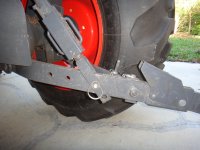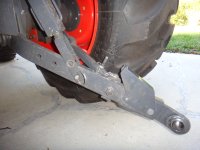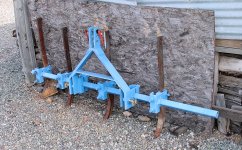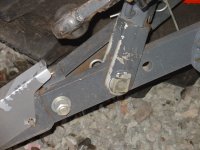jeff9366
Super Star Member
- Joined
- Jan 14, 2011
- Messages
- 12,787
- Tractor
- Kubota Tractor Loader L3560 HST+ ~~~~~~~~~~~~~ 3,700 pounds bare tractor, 5,400 pounds operating weight, 37 horsepower
The solution is to move the adjustment pins for the Three Point Hitch right and left Lifting Rod stirrups, which attach to the Lower Links, from the TOP hole to the LOWER hole. This will allow your ripper to drop down 3" to 5". Then play with Top Link length.
Removing pins is easier with implement removed. DO NOT POUND ON THE PINS WITH A STEEL TOOL TO GET THEM OUT, or you will convert the pins to rivets. (A brass or nylon drift is OK) Work in slack with the right Lifting Rod. Grease pins lightly. I use anti-seize compound but any grease is fine.
This pin adjustment is highly useful when using a Box Blade, Landscape Rake, Rear Blade and/or Turf Thatch Remover. Sometimes useful when operating a Field Cultivator.
Kubota L3560 photos:
#1 Standard position for Lower Link, stirrup pin in UPPER adjustment hole. Note Lower Link angle.
#2 Optional position for Lower Link, stirrup pin in LOWER adjustment hole. Note Lower Link drop.
Removing pins is easier with implement removed. DO NOT POUND ON THE PINS WITH A STEEL TOOL TO GET THEM OUT, or you will convert the pins to rivets. (A brass or nylon drift is OK) Work in slack with the right Lifting Rod. Grease pins lightly. I use anti-seize compound but any grease is fine.
This pin adjustment is highly useful when using a Box Blade, Landscape Rake, Rear Blade and/or Turf Thatch Remover. Sometimes useful when operating a Field Cultivator.
Kubota L3560 photos:
#1 Standard position for Lower Link, stirrup pin in UPPER adjustment hole. Note Lower Link angle.
#2 Optional position for Lower Link, stirrup pin in LOWER adjustment hole. Note Lower Link drop.
Attachments
Last edited:





